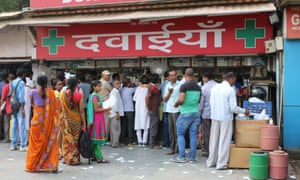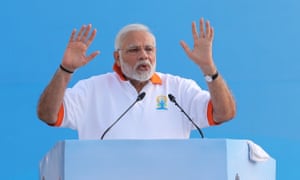
Pharmacy stalls do a brisk trade opposite Delhi’s All India Institute of Medical Sciences. The Jan Aushadi scheme has provided a lifeline for many poor people. Photograph: Michael Safi
A taciturn, heavy-set man, Khawar Khan is not given to smiling. Only when he recalls the relief flooding the faces of customers after he has sold medicines at a twentieth of the cost in other chemists does he smile broadly.
“An autorickshaw wallah broke down here. Medicines for his wife used to cost him a catastrophic 10,000 (£111) rupees a month, his entire monthly salary. I gave him a month’s supply for 2,200 rupees. His relief was something to see,” says Khan.
Had the autorickshaw wallah not learned of Khan’s special pharmacy, stocked only with low-cost, generic medicines supplied by the government, he would have become one of the 55 million Indians pushed into poverty each year because of the cost of treating an illness.
The figure was provided by experts at the Public Health Foundation of India and published in the British Medical Journal. Of the 55 million, 38 million fell below the poverty line due to spending on medicines alone.
Khan’s little store is in the crowded and scruffy neighbourhood of Jamia Nagar in New Delhi. The floor is clean. Medicines are neatly stocked on the white shelves. The store is part of the Jan Aushadhi government project to provide generic medicines (identical to branded drugs but, since they don’t include research and development costs, substantially cheaper) to poor people in India so that the potentially ruinous medical costs of an illness can be managed.
A taciturn, heavy-set man, Khawar Khan is not given to smiling. Only when he recalls the relief flooding the faces of customers after he has sold medicines at a twentieth of the cost in other chemists does he smile broadly.
“An autorickshaw wallah broke down here. Medicines for his wife used to cost him a catastrophic 10,000 (£111) rupees a month, his entire monthly salary. I gave him a month’s supply for 2,200 rupees. His relief was something to see,” says Khan.
Had the autorickshaw wallah not learned of Khan’s special pharmacy, stocked only with low-cost, generic medicines supplied by the government, he would have become one of the 55 million Indians pushed into poverty each year because of the cost of treating an illness.
The figure was provided by experts at the Public Health Foundation of India and published in the British Medical Journal. Of the 55 million, 38 million fell below the poverty line due to spending on medicines alone.
Khan’s little store is in the crowded and scruffy neighbourhood of Jamia Nagar in New Delhi. The floor is clean. Medicines are neatly stocked on the white shelves. The store is part of the Jan Aushadhi government project to provide generic medicines (identical to branded drugs but, since they don’t include research and development costs, substantially cheaper) to poor people in India so that the potentially ruinous medical costs of an illness can be managed.

Narendra Modi has injected fresh life into the Jan Aushadi scheme since his election as Indian prime minster in 2014. Photograph: Harish Tyagi/EPA
Started in 2008 by a previous government, the scheme foundered, mainly because pharmacies stocked so few drugs that hardly anyone bothered going to them. When the Narendra Modi government came to power in 2014, it gave the project a push, setting a target of 3,000 stores. From 97 pharmacies in 2014, there are now more than 3,000 countrywide.
This is a tiny figure for a country the size of India – some people have to travel long distances to find one – but it’s something. The only problem is providing the pharmacies with enough drugs.
“Most Jan Aushadhi stores have barely 100-150 formulations instead of the promised 600-plus medicines and their numbers are too small compared to the 550,000 pharmacies in India,” says the Public Health Foundation report.
Speak to the owners and they say even basic items, such as calcium supplements or oral rehydration salts, are often in short supply.
“I used to get only 30% of my orders from the government distributor. I hated sending patients away empty-handed, sometimes elderly people who had travelled 20 kilometres. Because I never had sufficient sales volume to make a profit, I was making a loss for a year. So I closed down last month,” says Shivdan Singh, whose shop was in Chhatarpur.
Khan is likewise failing to make a profit, but says he will give it another year before deciding what to do.
Advesh Kumar, deputy marketing manager of the Bureau of Pharma PSUs of India, the government agency that supplies the drugs, admits the stores lacked the full range of drugs. He says the bureau was not geared up to meet the demand generated by the sharp rise in the number of pharmacies.
“There is an undoubted shortage. Demand is higher than we anticipated. It’s also hard to predict which drugs will be needed. But we have got new software that will enable us to handle the issue better and we will plug the gap within two months,’ says Kumar.
As he sits in Khan’s store, Shazad Choudhury looks tense. Judging by the long list of prescriptions he has handed over to Khan, his entire extended family is ill with hypertension, diabetes, heart problems, kidney infections, uterus infections, and depression. Choudhury himself is recovering from a slipped disc.
“Look at all these medicines!” says Choudhury. “I’d be on the streets if I had to get these from a normal pharmacy. This scheme is a lifesaver. But it is tedious for me to keep waiting. There are two drugs I have been waiting for for a fortnight. The government must ensure the shops are fully stocked,” he says.
Outside the pharmacy, Kishore Dutt, a construction worker, is leaving, with medicines for his grandmother. He says some of his relatives told him to let his 82-year-old grandmother die because the medicines were too expensive. Poor families often have to make inhuman choices of this kind. Treat an elderly person, who may not even get better, and let the children go hungry? Or let that person die so that the children can eat and live?
Dutt heard about the Jan Aushadhi scheme and located Khan’s pharmacy. “I’m rushing back to my nani (grandmother). I hope these [drugs] will cure her,” he says.
Dutt was lucky that his grandmother’s doctor prescribed the generic name of the drugs. Many doctors in India, despite the Medical Council of India’s order to prescribe generic medicines, fail to do so. The perception that generic means no good and branded means good persists, even among doctors.
“The doctor down the road told a patient that generic drugs were ineffective. They need to be educated because they are doing a great disservice to the poor,” says Khan.